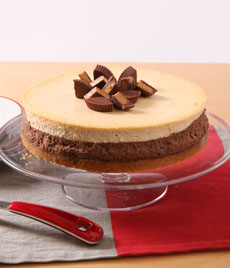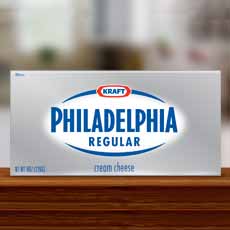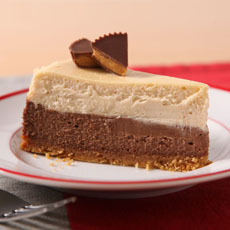Bake A Chocolate Peanut Butter Cheesecake
|
|
July 30th is National Cheesecake Day, so we’re publishing a few new recipes from Philadelphia Cream Cheese—the originator of the celestial cream cheese cheesecake. We hadn’t come across a chocolate peanut butter cheesecake recipe, and it brought back memories. We’ll never forget our first slice of chocolate peanut butter cheesecake, some fifteen years ago at a Cheesecake Factory restaurant. The slice was huge, no one wanted to split it with us, and—you guessed it—we ate the whole thing. While we’re a champion cheesecake eater, the richness of the chocolate and the peanut butter did us in for the rest of the evening, and we haven’t had chocolate peanut butter cheesecake since. Until now. Make this recipe from Philadelphia Cream Cheese and then protect your impulses by: > Here’s a second Chocolate Peanut Butter Cheesecake recipe. > The history of peanut butter. > The history of the peanut butter cup. Ingredients 1. PREHEAT oven to 325°F. 2. MIX the graham crumbs, butter, and 3 tablespoons of sugar. Press onto the bottom of a 9-inch springform pan. 3. BEAT cream cheese, peanut butter, and remaining sugar with a mixer until blended. Add sour cream and vanilla; mix well. Add eggs, one at a time, mixing at low speed after each, just until blended. 4. TRANSFER three cups of batter to a medium bowl; stir in the melted chocolate. Pour over the crust. Refrigerate the remaining batter until 30 minutes into baking. 5. BAKE the first layer for 30 minutes; then gently spoon the remaining batter over the partially baked layer. Continue to bake for a total of 1 hour or until the center is almost set. 6. REMOVE from the oven and run a knife around the rim of the pan to loosen the cake. Cool before removing the rim. Refrigerate for at least four hours. Garnish and serve. |
|
|
THE HISTORY OF CHEESECAKE & CREAM CHEESE Cheesecake dates all the way back to ancient Greece: Historians believe that a type of cheesecake was served to athletes during the first Olympic Games in 776 B.C.E. What type of cheesecake it was, and whether it was sweet or savory, is not known; but savory is a good guess. More than 500 years later, in De re Rustica (“On Agriculture”), the Roman statesman Marcus Porcius Cato (Cato the Elder) described making cheesecake. De re Rustica is the oldest known book of Roman prose; vis-à-vis the printed record, the cheesecake had arrived. Cheesecake—made with different fresh cheeses—traveled throughout Europe with the peripatetic Romans. But the history of modern cheesecake begins in 1872, when a dairyman named William Lawrence invented modern cream cheese in Chester, New York. It was a happy accident: Chester was trying to make Neufchâtel cheese*, a soft French cheese. With bricks of cheese wrapped in foil, Lawrence’s Empire Company began to distribute cream cheese in 1880. He called the product Philadelphia Brand Cream Cheese. At the time, Philadelphia was known for its fine cuisine; “Philadelphia” implied “gourmet.” In 1903, the Phoenix Cheese Company of New York bought the Empire Company and Philadelphia Brand Cream Cheese. In 1928, the Kraft Cheese Company bought the brand, which it owns to this day. And where would be without it? Imagine all those lonely bagels! Add an acid like lemon juice or vinegar to cream, which will coagulate the cream into curds and whey. Drain off the whey (you can drink it or otherwise cook with it), heat the curds, add with some salt and process in a food processor until creamy. Then, add to the fun by including fresh or dried fruits and vegetables, herbs, spices, even bacon or a way-out creative ingredient. Instead of pouring pepper jelly over a block of cream cheese, you can add the pepper jelly into the food processor mix. Have fun! _________________________ *American Neufchâtel cheese is different from French Neufchâtel; the latter is a mold-ripened cheese similar to Camembert. American Neufchâtel has approximately 33% lower fat than cream cheese and higher moisture content. It was long sold as a reduced-fat option to cream cheese. Philadelphia’s reduced-fat cream cheese, however, is far superior to any American Neufchâtel we’ve had. CHECK OUT WHAT’S HAPPENING ON OUR HOME PAGE, THENIBBLE.COM.
|
||






